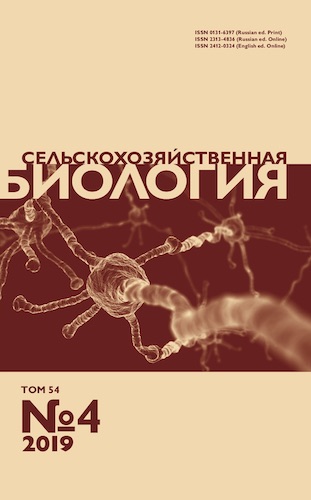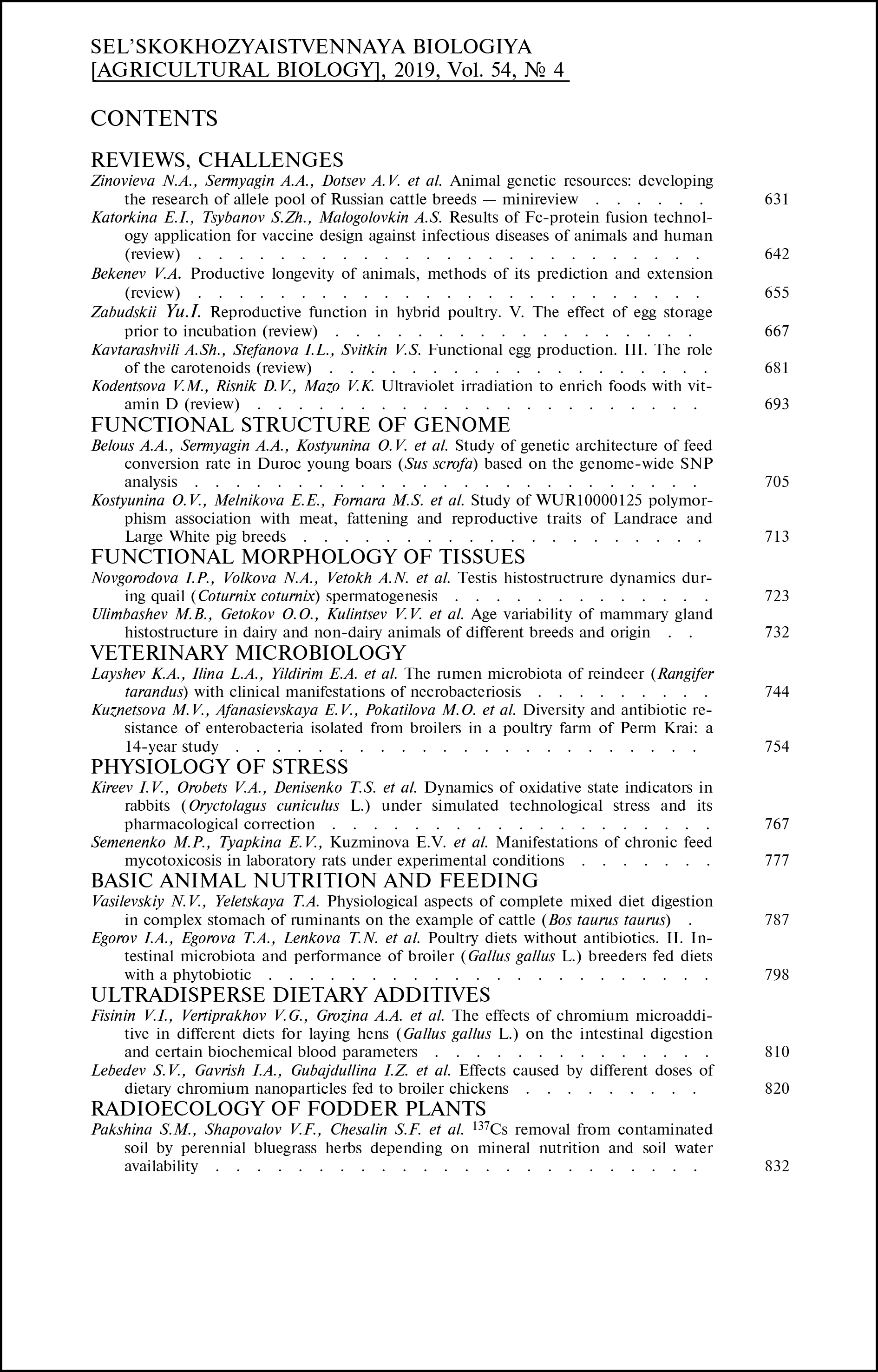doi: 10.15389/agrobiology.2019.4.787eng
UDC: 636.2:591.132:636.084.41
PHYSIOLOGICAL ASPECTS OF COMPLETE MIXED DIET DIGESTION IN COMPLEX STOMACH OF RUMINANTS ON THE EXAMPLE OF CATTLE (Bos taurus taurus)
N.V. Vasilevskiy, T.A. Yeletskaya
Institute of Animal Science of National academy of agrarian sciences
of Ukraine, 3, vul. 7-i Gvardeiskoi Armii, Kharkov, 61120 Ukraine, e-mail vasilevskii.n@mail.ru (✉ corresponding author), eletskatat@zandex.ru
ORCID:
Vasilevskiy N.V. orcid.org/0000-0002-7437-2910
Yeletskaya T.A. orcid.org/0000-0001-8980-6972
Received March 22, 2019
Modern systems of normalized cattle feeding are based on the position that different feeding technologies do not affect the processes of digestion and absorption of nutrients of the same diet. In our studies, data were obtained for the first time, indicating changes in the parameters of the ration digestion process in the complex stomach of cattle, depending on the method of feeding: separate delivery of separate feeds and simultaneous delivery by the form of the Total Mixed Ration (TMR). To determine mechanisms of increasing feed dry matter intake in cattle when they were switched to Total Mixed Ration feeding, daily flux rates of chyme, its chemical composition and digestibility of main nutrient groups in the compound stomach of young cattle were studied. A Latin square design experiment was carried out using two diets differing in the forage fodder to concentrated fodder ratio and two methods of feeding (separate distribution of feed and in the form of TMR) by the method of periods with two Ukrainian red-motley bulls (Bos taurus taurus) of 300 kg live weight, with a sluice T-shaped duodenal canula. As a result of switching to the TMR feeding, both the nature of chyme influx to the duodenum and nutrient digestibility in the complex stomach were found to change. For 1 hour, the volume of chyme during TMR feeding increased by 417±71 ml/h as compared to separate high concentrate diet feeding, while compared with low concentrate feeding, it increased by 221±81 ml/h, or by 14.42 % and 8.36 %, respectively (p < 0.001). TMR increased Ca, P and total mineral residue influx to the duodenum (by 5.9 %, 10.1 and 8.5 %, respectively). At that, the increase in Ca with the first diet and in general ash with the second one was established at a level of trend, whereas for all the others the increase was significant (р < 0.05). This fact as well as the observed tendency to a change in the Ca and P concentrations in the duodenal chyme composition suggest an increase in the outflow of chyme from the rumen caused by both increased salivation and consumption of water by the animals. The feeding of animals with the TMR was shown to cause multidirectional changes in digestibility of all nutrients: digestibility of raw fat and crude protein decreased in both diets (by 39.6 % and 27.5 %, respectively), while digestibility of crude fiber increased (by 6.9 %); digestibility of nitrogen-free extractives did not change significantly in the first diet, whereas it tended to decrease in the second one so that the total digestibility of the dry and organic matter of the diet changed insignificantly. Raw fiber should be considered as an integral marker for assessing the TMR effect for rumen’s digestion, since it is only digested in the rumen and is not synthesized by the microflora. Due to this, the increase in the chyme flow that we established, when we changed feeding method in the same type of diet, can reduce fiber digestibility due to accelerated outflow of rumen’s content with small particles, whereas with the other type of diet, on the contrary, can increase digestion due to improvement of fermentation conditions.
Keywords: Ukrainian red-motley cattle, digestion, chyme volume, fiber, total mixed ration.
REFERENCES
- Golder H.M., Denman S.E., McSweeney C., Wales W.J., Auldist M.J., Wright M.M., Marett L.C., Greenwood J.S., Hannah M.C., Celi P., Bramley E., Lean I.J. Effects of partial mixed rations and supplement amounts on milk production and composition, ruminal fermentation, bacterial communities, and ruminal acidosis. J. Dairy Sci., 2014, 97(9): 5763-5785 CrossRef
- Auldist M.J., Marett L.C., Greenwood J.S., Hannah M., Jacobs J.L., Wales W.J. Effects of different strategies for feeding supplements on milk production responses in cows grazing a restricted pasture allowance. J. Dairy Sci., 2013, 96(2): 1218-1231 CrossRef
- Mertens D.R. Creating a system for meeting the fiber requirements of dairy cows. J. Dairy Sci., 1997, 80(7): 1463-1481 CrossRef
- Teimouri Y.A., Valizadeh R., Naserian A., Christensen D.A., Yu P., Eftekhari Shahroodi F. Effects of alfalfa particle size and specific gravity on chewing activity, digestibility, and performance of Holstein dairy cows. J. Dairy Sci., 2004, 87(11): 3912-3924 CrossRef
- Mirzaei-Aghsaghali A., Maheri-Sis N. Importance of “physically effective fibre” in ruminant nutrition: a review. Annals of Biological Research,2011, 2(3): 262-270.
- Keunen J.E., Plaizier J.C., Kyriazakis I., Duffield T.F., Widowski T.M., Lindinger M.I., McBride B.W. Effects of a subacute ruminal acidosis model on the diet selection of dairy cows. J. Dairy Sci., 2002, 85(12): 3304-3313 CrossRef
- Spiekers H., Potthast V. Erfolgreiche Milchviehfütterung. DLG-Verl., Frankfurt am Main, 2004.
- Khan M.A., Bach A., Castells L., Weary D.M., von Keyserlingk M.A.G. Effects of particle size and moisture levels in mixed rations on the feeding behavior of dairy heifers. Animal, 2014, 8(10): 1722-1727 CrossRef
- Kononoff P.J., Heinrichs A.J., Lehman H.A. The effect of corn silage particle size on eating behaviour, chewing activities and rumen fermentation in lactating dairy cows. J. Dairy Sci., 2003, 86(10): 3343-3353 CrossRef
- Rottman L.W., Ying Y., Zhou K, Bartell P.A., Harvatine K.J. The effects of feeding rations that differ in neutral detergent fiber and starch concentration within a day on production, feeding behavior, total-tract digestibility, and plasma metabolites and hormones in dairy cows. J. Dairy Sci., 2015, 98(7): 4673-4684 CrossRef
- Kmicikewycz A.D., Harvatine K.J., Heinrichs A.J.Effects of corn silage particle size, supplemental hay, and forage-to-concentrate ratio on rumen pH, feed preference, and milk fat profile of dairy cattle. J. Dairy Sci., 2015, 98(7): 4850-4868 CrossRef
- Vasilevskii N.V., Eletskaya T.A. Tsyupko V.V, Berestovaya L.E. Problemy biologii produktivnykh zhivotnykh, 2013, 1: 67-74 (in Russ.).
- Aliev A.A. Noveishie operativnye metody issledovaniya zhvachnykh zhivotnykh [The latest surgical experimental techniques for ruminants]. Moscow, 1985 (in Russ.).
- Valigura V.I. Zakonomernosti perevarivaniya i ispol'zovaniya pitatel'nykh veshchestv i energii raznostrukturnykh ratsionov ovtsami. Doktorskaya dissertatsiya [Digestion and use of nutrients and energy of different diets by sheep. DSc Thesis]. Moscow, 1990 (in Russ.).
- Laboratornі metodi doslіdzhen' u bіologії, tvarinnitstvі ta veterinarnіi meditsinі[Laboratory research methods in animal biology, animal husbandry and veterinary medicine]. L'vіv, 2012.
- Tsyupko V.V., Pronina V.V., Berus M.V. et al. Metodicheskie rekomendatsii po normirovaniyu energii v kormlenii krupnogo rogatogo skota. Khar'kov, 1989 (in Russ.).
- AFRCTechnical Committee on Responses to Nutrients, Report number 5, Nutritive requirements of ruminant animals: energy. Nutrition Abstracts and Reviews. Series B, Livestock Feeds and Feeding, 1990, 60(10): 729-804.
- Physiology of Digestion and Metabolism in the Ruminant. Proc. of the Third International Symposium, Cambridge, England, August 1969. A.T. Phillipson (ed.). Oriel Press Limited., 1970.
- Chichilov A.V. Vydelenie makroelementov okoloushnymi slyunnymi zhelezami laktiruyushchikh korov v svyazi s rubtsovym metabolizmom. Avtoreferat kandidatskoi dissertatsii [Secretion of macronutrients by the parotid salivary glands of lactating cows in connection with rumen metabolism. PhD Thesis]. Moscow, 1984 (in Russ.).
- Ishler V.A., Heinrichs A.J., Varga G.B. From feed to milk: understanding rumen function. Pennsylvania State University, 1996.
- Beal A.M. Salivary electrolyte concentrations and electrical potential difference across the parotid salivary duct of anaesthetized sodium-replete sheep. Australian Journal of Biological Sciences, 1980, 33(2): 197-204.
- Ruzanov V.E. Obmen kaliya, natriya i khlora u korov cherno-pestroi, golshtino-frizskoi porod i ikh pomesei. Avtoreferat kandidatskoi dissertastsii [Exchange of potassium, sodium and chlorine in black-motley and Holstein-Friesian cows and their crossbreeds. PhD Thesis]. Moscow, 2002 (in Russ.).
- Aliev A.A. Progress in digestion physiology of agricultural animals at the twentieth century (principal conception). Sel'skokhozyaistvennaya biologiya[Agricultural Biology], 2007, 2: 12-23 (in Russ.).
- Tirloni L., Reck J., Terra R.M., Martins J.R., Mulenga A., Sherman N.E., Fox J.W., Yates III J.R., Termignoni C., Pinto A.F.M., Vaz I.daS. Jr. Proteomic analysis of cattle tick Rhipicephalus (Boophilus) microplus saliva: a comparison between partially and fully engorged females. PLoSONE, 2014, 9(4): e94831 CrossRef
- Borovskii E.V., Leont'ev V.S. Biologiya polosti rta [Oral biology]. Moscow, 1991 (in Russ.).
- Olsson K., McKinley M.J.Central control of water and salt intake in goats and sheep. In: Digestive physiology and metabolism in ruminants. Y. Ruckebusch, P. Thivend (eds.). Springer, Dordrecht, 1980: 161-175 CrossRef
- Schröder B., Vössing S., Breves G.In vitro studies on active calcium absorption from ovine rumen. Journal of Comparative Physiology B, 1999, 169(7): 487-494 CrossRef
- Grabherr H., Spolders M., Lebzien P., Hüther L., Flachowsky G., Fürll M., Grün M. Effect of zeolite A on rumen fermentation and phosphorus metabolism in dairy cows. Archives of Animal Nutrition, 2009, 63(4): 321-336 CrossRef
- Erskov E.R., Ril M. Energeticheskoe pitanie zhvachnykh zhivotnykh [Energy nutrition of ruminants]. Borovsk, 2003 (in Russ.).
- Mutsvangwa T., Davies K.L., McKinnon J.J., Christensen D.A. Effects of dietary crude protein and rumen-degradable protein concentrations on urea recycling, nitrogen balance, omasal nutrient flow, and milk production in dairy cows. J. Dairy Sci., 2016, 99(8): 6298-6310 CrossRef
- Sun F., Aguerre M.J., Wattiaux M.A. Starch and dextrose at 2 levels of rumen-degradable protein in iso-nitrogenous diets: effects on lactation performance, ruminal measurements, methane emission, digestibility, and nitrogen balance of dairy cows. J. Dairy Sci., 2019, 102(2): 1281-1293 CrossRef
- Fessenden S.W., Foskolos A., Hackmann T.J., Ross D.A., Block E., Van Amburgh M.E. Effects of a commercial fermentation byproduct or urea on milk production, rumen metabolism, and omasal flow of nutrients in lactating dairy cattle. J. DairySci., 2019, 102(4): 3023-3035 CrossRef
- Skopichev V.G., Yakovlev V.I. Chastnaya fiziologiya. Chast’. 2. Fiziologiya produktivnykh zhivotnykh [Special physiology. Part 2. Physiology of productive animals]. Moscow, 2008 (in Russ.).
- Vasilevskii N.V. Dostupnost' syrogo proteina dlya perevarivaniya v tonkom kishechnike i postuplenie endogennogo azota v slozhnyi zheludok bychkov. Kandidatskaya dissertatsiya [Availability of crude protein for digestion in the small intestine and entry of endogenous nitrogen into the complex stomach of young steers. PhD Thesis]. Khar'kov, 1993.












